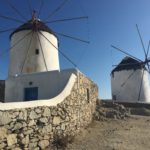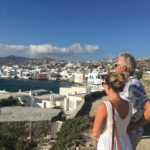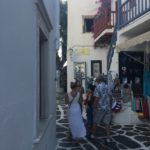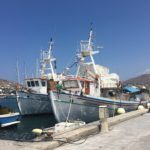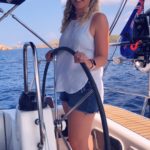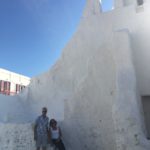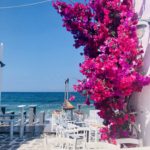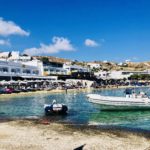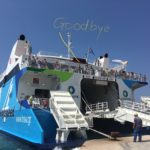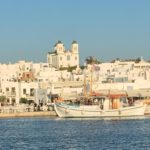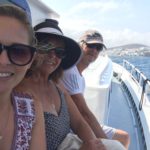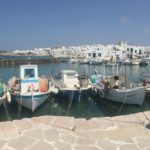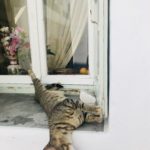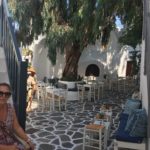Blowing dogs off chains
Where we’ve been and where we are now ….. (the big red arrowhead is our current position)
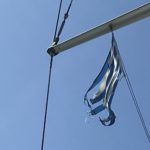
Our Greek courtesy flag after 2 weeks of Meltemi. There’s a fine for not showing respect for their flag. Time to buy a new one!
“Meltemi, or otherwise Greek “etesian” (annual) wind, is the strong & dry North wind which occurs in the Aegean Sea/ Greece & many other regions around the Mediterranean Sea.The Meltemi usually blows throughout the summer season (June to September) and is strongest during the afternoon and often dies down at night sometimes lasting for days without a break. Meltemi averages usually 4-5 (13 – 21 kts) Beaufort Scale however, it can reach 5-7 (13 – 37 kts) sometimes even 8 (38 to 40 kts) on the Beaufort Scale”
This wicked wind from the West (north west actually) has decided to hound us for the past two weeks making our visitors sea sick and meaning it has often been too windy and the sea state too confused to be able to venture far. Kara wanted to see Mykonos so because it was so windy we were not able to anchor in Ormos Harbour off the main town but instead went around to a much more sheltered bay called Platys Gialos.
We took the dinghy ashore and caught the bus to the main town. Mykonos was it’s usual bustling self packed with tourists cramming the narrow cobbled streets. It was as picture-perfect as all the photos show. The windy conditions meant that some of the seafront tavernas were closed and others were too windswept to be comfortable. I think this may have been why the town did not seem overcrowded – perhaps the tourists were having a day elsewhere.
We had great downwind sailing the next day from Mykonos to Paros. We hit a top speed of 8.9 knots with only a reefed jib (I know, the photo only shows 8.4 which is my fault for not being quick enough!)
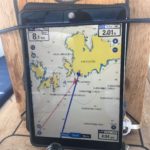 It was a bit uncomfortable as the sea state was chaotic so we reduced sail and cruised along averaging 7 knots. The Meltemi continues to blow so we took shelter in a big bay at the northern end of Paros called Naoussa . From here we were able to dinghy to the dock and catch a local ferry to the town of Naoussa which was another picture perfect Cyclades village with brilliant white plastered buildings, bougainvillea climbing carelessly over walls and more Tavernas than you could poke a stick at.
It was a bit uncomfortable as the sea state was chaotic so we reduced sail and cruised along averaging 7 knots. The Meltemi continues to blow so we took shelter in a big bay at the northern end of Paros called Naoussa . From here we were able to dinghy to the dock and catch a local ferry to the town of Naoussa which was another picture perfect Cyclades village with brilliant white plastered buildings, bougainvillea climbing carelessly over walls and more Tavernas than you could poke a stick at.
Naoussa has great 1/2 hourly bus service to Paroikia, the main town on Paros, where the ferry terminal is. We ventured over there to check out the anchorage and had a chat with the Port Captain who mentioned that the Charterers would be leaving the next day so we could try for a spot on the town quay.
The following day we had a brisk sail down the coast and found a very good anchoring spot on a nice sandy bottom not far from the town. Kara was due to depart on the fast ferry back to Athens on Friday morning and then home to Sydney. It was good being a day early so there was no stress about catching the ferry and making the connections. We had some shopping time are both had a pair of shoes made – same day service. Luckily she had allowed a few extra hours because her ferry was quite late but she made her connections and 34 hours later was home.
On Sunday we were able to get a spot on the town quay (EUR 12 per day which included electricity and water – what a bargain!) John’s sister Ann, together with husband Alex plus Charlotte (14) and Ben (12) (the Hursts) were due in on the 7pm ferry on Sunday night from Athens so we spent our time cleaning and washing and generally tidying up the boat in preparation for our next visitors. We had planned to have a couple of nights on the dock to explore Paros before heading out to the islands but the weather was deteriorating as the Meltemi continued so we decided to gap it the next morning and head for the island of Sifnos. It was quite a wild ride and some of the crew were seasick (NOT me this time – I had taken my tablet earlier). We put the fishing lines out along the way but I’m sure there are no fish in the Mediterranean Sea. Anchoring 4 hours later in a relatively calm bay spirits were restored. We all swam and later went ashore to a taverna for something to eat. The food is fairly inconsistent – sometimes the squid and fish is delicious and then next time very chewy. We have practically become vegetarians as they grow the best tomatoes, zucchini, eggplant and fresh herbs and make the most interesting and tasty vegetarian dishes I have tasted . Meat (except pork) is something we generally avoid as the beef and lamb are consistently over cooked and dry. Pasta dishes are fantastic as well as the traditional Gyros and of course Greek salad. It’s all interesting and part of the experience we are having.
We spent the next few days trying to find sheltered anchorages and stay out of the wind. We did find a nice one at Faros on Sifnos – as far south as we wanted to go, which was a very deep inlet where we were able to anchor right up close to the beach and be only one of three boats there for the night. We followed a track and walked around the headland from our deserted bay to civilization for an ice cream and had some snorkeling and swimming in the clear blue water. The Hursts were due out on the ferry early on Saturday morning so we had a deadline to meet with the need to be back in 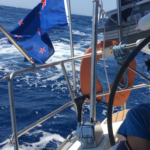 Paroikia, Paros by Friday night. With the weather looking like it was only going to get worse we decided to head back towards Paros on Wednesday and after an exhilarating 3 hour sail we were anchored in Despotiko, Antiparos – closer to our target and hopefully reachable on Thursday, which was much earlier than we had planned. When the Meltemi blows for days as it had been the sea gets very rough and choppy. The only way to get back to Paroikia was to head straight into the wind and waves and bash our way back. After a couple of hours we were only making ground at 2 -3 nautical miles per hour and sometimes were actually not making headway against the waves and wind. It is really uncomfortable so I quickly checked and found an anchorage (Aliki) on the south end of Paros where our guests could travel by bus (18 minutes) to the port, so we changed direction and headed for some relief. The following day (Friday) we waved them off on the bus to Paroikia where they stayed the night and made it to their early ferry with ease.
Paroikia, Paros by Friday night. With the weather looking like it was only going to get worse we decided to head back towards Paros on Wednesday and after an exhilarating 3 hour sail we were anchored in Despotiko, Antiparos – closer to our target and hopefully reachable on Thursday, which was much earlier than we had planned. When the Meltemi blows for days as it had been the sea gets very rough and choppy. The only way to get back to Paroikia was to head straight into the wind and waves and bash our way back. After a couple of hours we were only making ground at 2 -3 nautical miles per hour and sometimes were actually not making headway against the waves and wind. It is really uncomfortable so I quickly checked and found an anchorage (Aliki) on the south end of Paros where our guests could travel by bus (18 minutes) to the port, so we changed direction and headed for some relief. The following day (Friday) we waved them off on the bus to Paroikia where they stayed the night and made it to their early ferry with ease.
It’s very strange to have the boat back to ourselves. We miss the hustle and bustle of having kids onboard – and having endless games of Yahtzee, Pass the Pigs and cards, plus always someone swimming off the back or jumping off the bow (Ben Hurst – you know who you are!).
We have had huge winds and gusts at the anchorage the whole time we have been here and have only been ashore once. 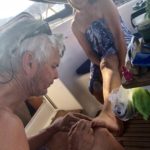 Cap’n John is starting to get cabin fever so I gave him some projects – design a new stay sail for the back of the boat to stop us swinging around so much at anchor, fitting of the wifi ‘borower’ which boosts the signals received from shore, and paint my toenails see picture: We have decided to have another go at getting to Paroikia ourselves tomorrow. We are getting low on fresh water and need to do a bit of washing so some time on the town quay again would be nice. We got up at O’dark 30 (5.30 am) and left while it was getting light in a nice 11 knots of breeze. You certainly have to be early to beat the Meltemi. We only had 10 nm to get to the port but it was through the Antiparos channel which is not very wide and not very deep with lots of very sharp rocks both above and below water. Our pilot guide says not to attempt it unless the conditions are good (they weren’t) with no Meltemi blowing (it was) and in the middle of the day (no but at least it was daylight) . I think navigation aids such as Navionics have improved dramatically since the book was written because we were able to miss the hazzards and motored into the 18 knot headwind for 2 hours to reach the harbour safely. We did see two metres (s**t) on the depth sounder at one stage, as we expected, so I held my breath and we were through.
Cap’n John is starting to get cabin fever so I gave him some projects – design a new stay sail for the back of the boat to stop us swinging around so much at anchor, fitting of the wifi ‘borower’ which boosts the signals received from shore, and paint my toenails see picture: We have decided to have another go at getting to Paroikia ourselves tomorrow. We are getting low on fresh water and need to do a bit of washing so some time on the town quay again would be nice. We got up at O’dark 30 (5.30 am) and left while it was getting light in a nice 11 knots of breeze. You certainly have to be early to beat the Meltemi. We only had 10 nm to get to the port but it was through the Antiparos channel which is not very wide and not very deep with lots of very sharp rocks both above and below water. Our pilot guide says not to attempt it unless the conditions are good (they weren’t) with no Meltemi blowing (it was) and in the middle of the day (no but at least it was daylight) . I think navigation aids such as Navionics have improved dramatically since the book was written because we were able to miss the hazzards and motored into the 18 knot headwind for 2 hours to reach the harbour safely. We did see two metres (s**t) on the depth sounder at one stage, as we expected, so I held my breath and we were through.
Next on the agenda is some forward planning for the next and final 3rd of our adventure!

